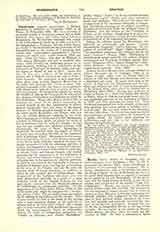

Braulio, Saint, Bishop of Saragossa, date of birth unknown; d. at Saragossa c. 651. In 631 he succeeded his brother John, whose archdeacon he had been, in the episcopal See of Saragossa. His influence extended not only to the bishops, but also to the Kings of Spain. In one of his letters (no. xxxvii) he urged King Chindaswinth to appoint a co-regent in the person of his son Receswinth. To his insistence with his friend Isidore of Seville, is due the inception and completion of the latter’s “Libri Etymologiarum”. Braulio was present at the synods held in Toledo in 633, 636, and 638. The members of the last-mentioned council selected him to write an answer to Pope Honorius I, who had reproached the Spanish bishops with negligence in the performance of their pastoral duties. Braulio in his letter (no. xxi) cleverly and fearlessly defended the conduct of the Spanish episcopate. Towards the end of his life, he complained bitterly of the loss of his eyesight. He was buried in the church of Nuestra Senora Merced del Pilar, where his tomb was discovered in 1290. His feast is celebrated in Spain on March 18, while the Roman Martyrology has it on the 26th.
Braulio is the author (I) of a life of St. Emilian (Emilianus Cucullatus, or San Milian de la Cogolla), a priest of the Diocese of Turiasso, now Tarazona, and the writer of a hymn in honor of the same saint. (2) A collection of forty-four letters, of which there is no mention in antiquity, was discovered in the eighteenth century in the Spanish city of Leon. They form a valuable addition to our knowledge of the history of Spain under the Visigoths and were first published in the “Espana Sagrada” of Florez (XXX, 1775). (3) The division and titles of the “Etymologiarum Libri 20” of St. Isidore and a eulogistic notice of the latter’s life, together with an enumeration of his writings, are also Braulio’s work. This notice and catalogue he added to the “De Viris Illustribus” of Isidore. It is found printed in Migne, P.L. (LXXXI, 15-17). (4) Braulio’s author-ship of the “Acts of the Martyrs of Saragossa” is usually admitted. He may also have written the “Passio S. Leocadi”. His works are accessible in P.L., LXXX, 639-720.
A. WEBER

